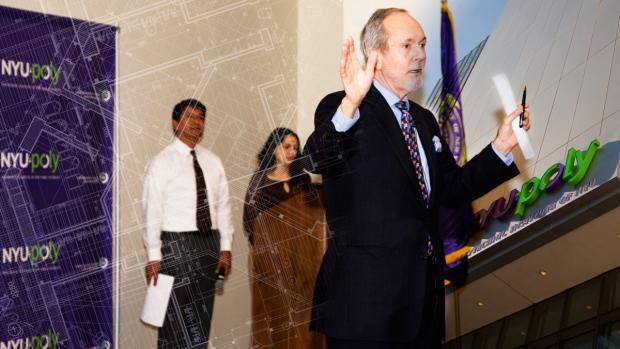New Decade, New Campus: NYU-Poly Announces the Transformation of its Brooklyn Campus

President Jerry M. Hultin unveiled “i2e Campus Transformation,” Polytechnic Institute of NYU’s plan to redesign areas of its Brooklyn campus, at a Town Hall on January 20. “The goal now is to turn this into a campus that exudes innovation, invention, and entrepreneurship,” he said, speaking at Pfizer Auditorium.
Dennis Dintino, interim vice president of finance and administration and chair of the project’s steering committee, echoed that sentiment when he said, “We want a campus transformation that supports students and faculty but that provides innovative and collaborative work spaces as we go forward.”
Dintino provided information about the project’s framework, such as its timeline (it’ll consist of three phases: 1 to 3, 3 to 5, and 5 to 10 years) and its funding ($50 million initially with fundraising targets eyeing $150 to $200 million more as the decade progresses).
[GALLERY:2662|left]Members of the project team from Jonathan Rose Companies, the firm NYU-Poly selected as its owner’s representative for i2e Campus Transformation, steered the lively Town Hall gathering through an overview of the project, covering its driving principles (sustainability goals and a transparent decision-making process, for instance) and introducing design ideas for the audience to consider during the question-and-answer period that followed.
Jonathan Rose, the company’s founder, presented examples of grand architectural transformations attendees were encouraged to draw inspiration from, including before-and-after images of Lincoln Center’s Alice Tully Hall and the new Cooper Union Building. He also shared examples of form meeting function in research and teaching labs with data and electrical ports suspended from the ceiling, enabling students, faculty, and researchers to easily move wheeled stations as needed. “We’re trying to design not just for the next 10 years, but for the next 50,” said Rose.
Audience members responded enthusiastically, with students, faculty, and administrators queuing to ask questions and provide comments. Proposals ranged from extra recreational spaces to creating continuity between the look and feel of the campus’ two main buildings, Rogers Hall and the Dibner Building. “The public outreach is good,” said attendee Brian Gill, a graduate student in NYU-Poly’s civil engineering master’s program.
“The best way to get funding is to get everybody aboard,” he continued. “If you inspire people, if you do something that hasn’t been done before — wow, that will really get people’s attention.”
President Hultin encouraged such involvement, reminding attendees of their stake in the project. “Staying engaged is as much as your responsibility as it is ours,” he said during closing remarks.
Interested parties can look forward to at least three more i2e Campus Transformation public workshops where they can share additional ideas that will shape NYU-Poly’s future.




